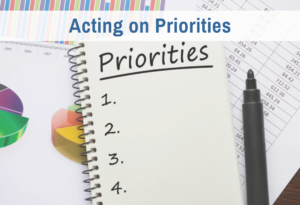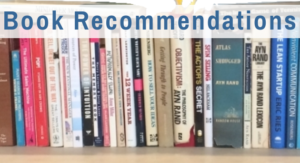My list of “Top Ten Thinking Tactics” has evolved over time. Many years ago, I sent out a postcard that listed the top ten thinking tactics as:
- Think on paper in full sentences.
- Overloaded? Make a list.
- Confused? Ask yourself “What DO I know?”
- Stuck? Complain to yourself about why.
- Blank? Make a “maybe” list.
- Lost? Get an overview.
- Overwhelmed? Scale down the goal.
- Flailing? Look for a skipped step.
- Aimless? Make the goal clearcut, doable, and important.
- Resistant? Identify the fear.
I stand by this advice but it’s a little brief. Looking back, most of these lines are quick words of wisdom for what to do when you’re stuck. The advice isn’t substantive enough to be tactics. A true tactic is a process with steps and principles.
With this in mind, I put together an instruction manual for the top ten thinking tactics I teach: The Thinker’s Toolkit: How to Focus Your Thoughts for Action and Other Thinking Tactics. The tactics are:
1. Thinking on paper
The Toolkit includes the 14-page article explaining the basics of “thinking on paper” that I first published as a pamphlet in 2006. If you are reading my newsletter and don’t know or use “thinking on paper,” please zip over to my website to get the Thinking Directions Starter Kit freebie, which has a soft copy of the article. “Thinking on paper” is the simplest, easiest way to increase your effective thinking power. It is also the foundation for every other tactic. With a printed copy of The Thinker’s Toolkit, I include a thinking notebook to get you started.
2. Prepared Questions
Once you learn “thinking on paper,” you can take advantage of all kinds of expert advice. One of the tactics I recommend is that you collect sets of questions from experts on different topics. In the Toolkit, I explain how to use these questions and include 31 sets of expert questions on ten topics ranging from goal-setting to dealing with emotional issues and presenting ideas.
For example, the first set of prepared questions in the Toolkit is an expansion of #3 from the postcard. When you’re confused or uncertain, I recommend you answer this trio of questions:
- What do I know?
- What do I need to know?
- What else is relevant?
If you go through my Tap Your Own Brilliance class, I teach this as a tactic. You learn that these three questions accomplish an important shift: they ensure you are focused on your strengths instead of your weaknesses. They lay out the context within which you can establish clarity and/or certainty. They direct you to solidify the foundation on which you will build new knowledge.
It’s helpful to know why they work, but it’s also helpful to have a shortcut. That’s what prepared questions are.
3. Complaining
When you’re in any sort of conflict, you need to give the contrary motivation a fair hearing. Unfortunately, sometimes you will be tempted to censor one side or the other. The tactic I use to loosen the tongue is “complaining.” In the Toolkit, I explain how to use specific sentence stems to get the complaints out in the open without collateral damage.
4. Mental Cleanup
A mental cleanup is a simple tactic in which you identify takeaways, open questions, and next steps given what you know right now. I recommend you do a mental cleanup at the end of any messy thinking process. It is especially helpful when you’re interrupted or have run out of time, because the takeaways, open questions, and next steps serve to capture your mental state. It is much, much easier to get back into the thinking groove after reviewing your mental cleanup. This is such a valuable tactic that I have created mental cleanup sticky pads, so that you can fill out a sheet, then stick it on your interrupted work so you know exactly what to look at when you get back to it.
5. Introspection 101
Introspection is the process of identifying what you feel and why you feel it. It is a crucial skill. Ayn Rand said, “If men identified introspectively their inner states one tenth as correctly as they identify objective reality, we would be a race of ideal giants.” Introspection 101 is a tactic I developed to teach you to recognize a large number of emotions and easily be able to identify their underlying evaluations. It turns an essay-question test into multiple choice. After you have used the Introspection 101 tactic 5-10 times, you will have an understanding of your feelings that will make every internal obstacle easier to identify and overcome.
6. Empathy Bath
Have you ever gotten deep visibility from someone who identified the deeper meaning in what you said? Someone who put a name to the values you were struggling to express? That type of visibility comes from empathy. When you can express that deep meaning for yourself, you ground yourself emotionally and fill your emotional reservoirs with energy. I developed the Empathy Bath technique to teach people to do this. The method starts with an introspection process, then adds on a value-identification process. Hat Tip to Marshall Rosenberg, who taught me the value of empathy and self-empathy.
7. Judge Your Neighbor
Have you ever lost a few hours caught up in anger over other people? When you lose that much time in emotional upset, it is worth taking some time to get to the bottom of the issue and resolve it. The truth is, that kind of upset always involves a self-esteem issue. It’s never just about the other person. I adapted the tactic “Judge Your Neighbor” from Byron Katie’s method of this name. It takes a fair amount of time, but it always enables you to challenge distorted perceptions and find your own contribution to the problem. It lets you figure out what is under your control and what is not, and accept those facts. Every time I use this technique I get a major insight — and so do those to whom I have taught it.
8. Decision Cards
The best decision process I ever learned, I learned from P.J. Eby, and I write it up in The Thinker’s Toolkit as “Decision Cards.” It is a powerful method for making sure that you hold the full context and make your decisions on the basis of values, not threats. In the course of making the decision, you wind up listing positives and negatives. I have my clients use green ink for positives and red for negatives to reinforce the distinction between them — and I provide a Thinking Directions 4-color pen for doing it! The pen is also great for marking up your thinking on paper on a second pass.
9. The AND List
The AND List is one of the simplest, fastest tactics I teach. It can help you resolve temptation or resistance in just a few minutes and if it doesn’t, it shows you exactly what the issue is that needs more attention. I teach the AND List in my teaser class, Own Your Motivation.
10. The 15-Second Check
One of the most important tactics I teach is also one of the fastest. Take 15 seconds to write out a reason for your conclusion in a full sentence — whatever the conclusion is. In the writeup for this tactic, I explain why this is so important and how it will eliminate kicking yourself for mistakes.
* * *
These are ten of the 50 tactics available in the Thinking Lab library of tools. I included these ten tactics in my 56-page manual, The Thinker’s Toolkit, because they are the ones I use and recommend the most. I include the full Toolkit — with the pen, pads, and notebook — with many offerings.
Would you like to purchase the Thinker’s Toolkit?
The printed manual plus branded items shown in the picture is $40.
A PDF of just the 56-page manual is $20.
Payment links are below:
PDF of Thinker’s Toolkit manual
Thinker’s Toolkit — Ship to USA Only
Sorry, we don’t ship out of the USA anymore, because it’s not practical. This will change when we can get it in print at Amazon. In the meantime, we recommend the PDF version.








0 Comments